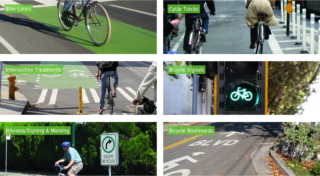
(Photos: NACTO)
After a year and a half of lobbying, the Oregon Department of Transportation has formally recommended that its street designers look for ideas in one of the country’s most progressive bikeway design books.
The Urban Bikeway Design Guide by the National Association of City Transportation Officials was one of the country’s first official documents to include design elements like protected bike lanes, bike boulevards, floating bus stops and bike-specific traffic signals. Some of its concepts are already in Oregon’s in-house bikeway design guide, but NACTO has asked allied states and cities to endorse its guide in order to lend legitimacy to the designs in less progressive states.
Virtually all of these designs are inspired by the Dutch streets manual and repurposed for U.S. streets — which tend to be wider, with more attention to people with disabilities, more on-street parking and traffic signals instead of roundabouts. (Another feature of U.S. streets: about three times as many traffic deaths.)
Preceding Oregon in endorsing NACTO’s guide were Washington, Massachusetts, California, Colorado, Delaware, Georgia and Virginia. Also, 54 cities (including Portland), one county and the Federal Highway Administration have signed on.
Advertisement
The entire effort has been a sort of proxy war by street-design progressives against conservative members of the American Association of State Highway and Transportation Officials. AASHTO is a private association, governed mostly by engineers at state DOTs, that publishes the country’s most widely used design manuals. AASHTO and its counterparts on the National Committee on Uniform Traffic Control Devices (another private engineers’ association that has been granted regulatory power over traffic signals and on-street markings by the federal government) has spent the last few decades ignoring or rejecting the sorts of bike infrastructure used in bike-friendly cities in Europe, Asia and elsewhere.
Back in April 2014, when Massachusetts and California endorsed the NACTO guide, we listed an endorsement of the NACTO guide among five good biking ideas that Oregon could lift from other states. It’s great news that the state has done so.
In the meantime, of course, national norms have continued to shift. The Massachusetts DOT is about to release a bikeway design guide that goes well beyond NACTO to include engineering-level detail for newer Dutch-inspired designs like protected intersections. California is preparing to follow suit.
NACTO is working on the next edition of its Urban Bikeway Design Guide, and AASHTO officials say they’re likely to include protected bike lane guidance in their next bike guide, due in 2017.
Oregon, too, is preparing to circulate a new version of its statewide biking and walking ‘modal plan’ for public comment. It’ll be interesting to see if that plan endorses one of the signature concepts behind NACTO’s bike guide: that protected bike lanes, not painted stripes, are the appropriate treatment for bikes on high-traffic or high-speed streets.

